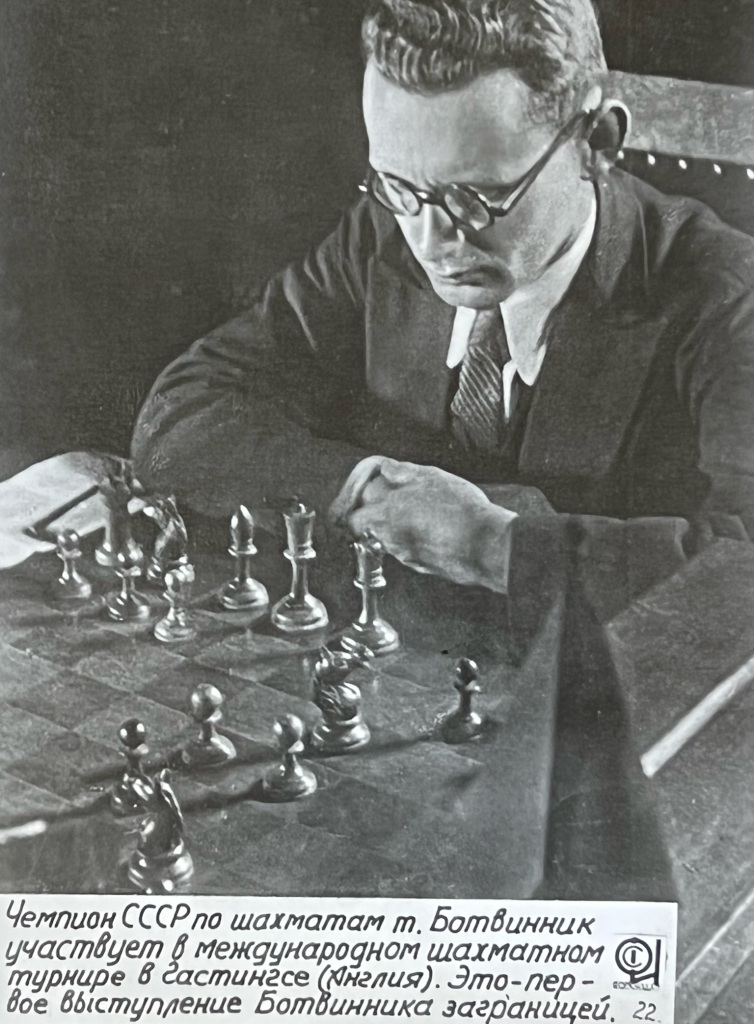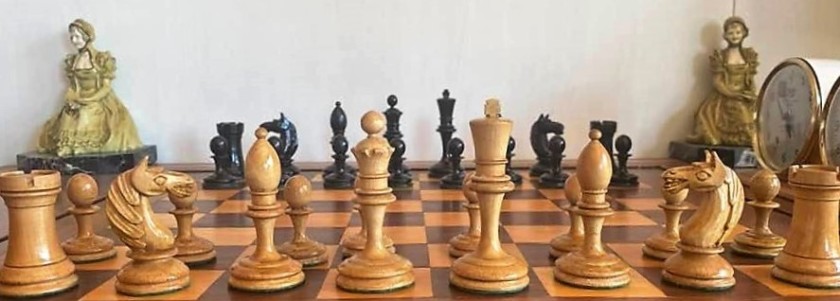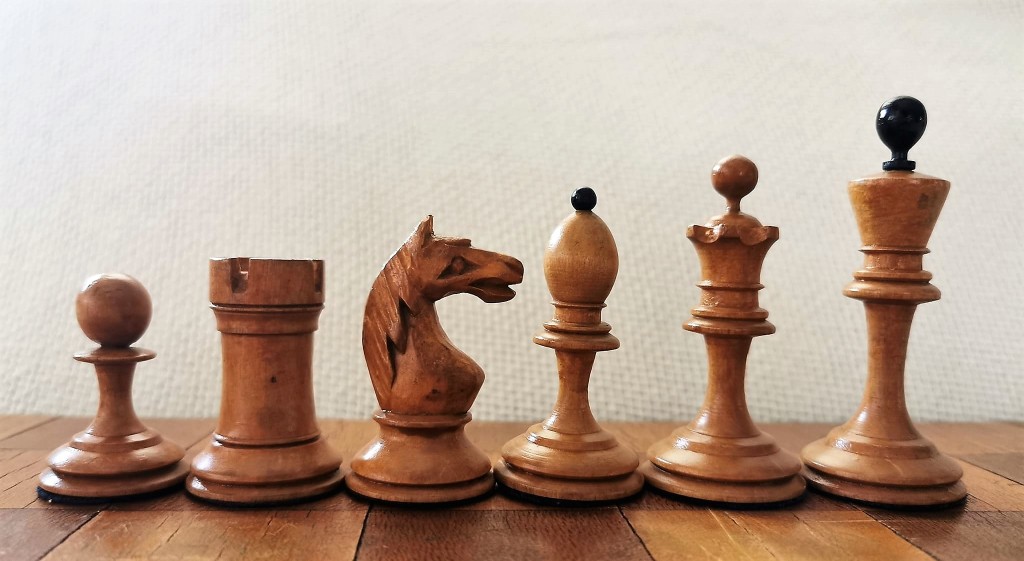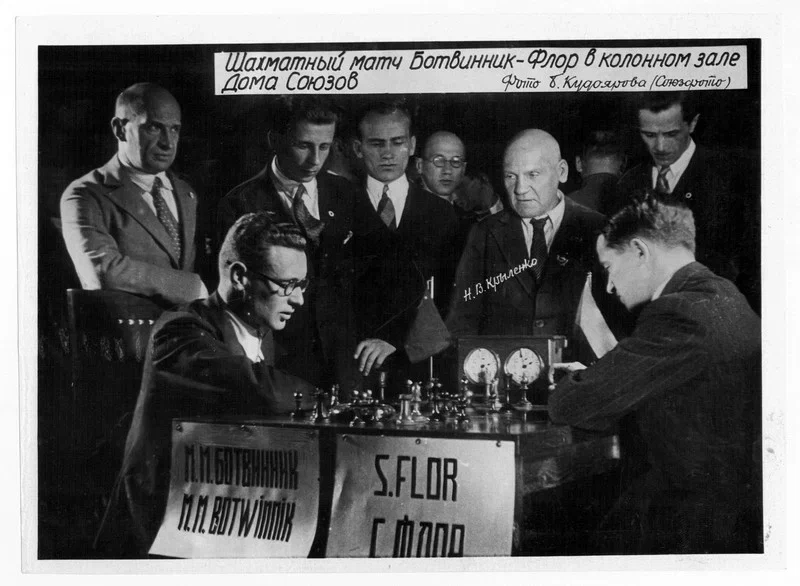Confusion remains as to the identity of the set (or sets) used in the 1933 Match between the Soviet Mikhail Botvinnik and then-Czech Grandmaster Salo Flohr. The Match, comprising twelve games, six of each played in Leningrad and then Moscow, was engineered by Nikolai Krylenko, head of the Soviet Chess and Checkers Section, editor of 64 magazine, and Soviet Commissar of Justice to pit the rising Red Star against Flohr, then considered to be a leading challenger for the world championship. Krylenko sought to gauge the progress of his program of political chess in achieving its goal of surpassing the West in this arena of cultural and intellectual competition. Wrote Krylenko in the introduction to Botvinnik’s book on the match:
The moment came when we had to test our quality growth, our strength against the professionals of Western Europe. This was the first purpose of the Flohr-Botvinnik match we organized.
M. Botvinnik, Botvinnik – Flohr: Match 1933 at p. 5 (Kindle Edition, 2020).
Sources of Confusion
One source of the confusion stems from the close proximity of the 1933 match to the 1935 Second Moscow International Tournament, where Flohr and Botvinnik drew their only game and shared first place ahead of former world champions Emanuel Lasker and Jose Raul Capablanca; and the 1936 Third Moscow International Tournament, where Botvinnik won the famous “Mop the Flohr” game en route to taking second place behind Capablanca, Flohr finishing third. Photos of the three events, often lacking proper labels, were conflated and confounded, even in Botvinnik’s book on the match, and the sets used in the 1935 and 1936 events were thought by some to be those used in 1933.
Recent research has determined that the 1935 and 1936 Moscow events used one design, and the 1933 match another. The design used in those events has been definitively identified and has come to be known as the Botvinnik-Flohr II (or BFII) set. The set used in the 1933 match has come to be known as the Botvinnik-Flohr I (or BFI) set so as to distinguish it from the later design. Although this distinction has allowed us to identify and study the BFII design in its evolving variations, it has not clarified the identity of the 1933 Match set
A second source of the confusion is the paucity of photos of the 1933 Match that have sufficient clarity to readily identify the set used. Because photographic evidence from the 1933 Match is so scarce and of such poor resolution, collectors, myself included, and others have misidentified the design actually used, and only compounded confusion by repeating the mistake as if it was an established historical fact.
A third source of the confusion is that the numbers of Soviet sets and their many creative designs had not yet begun to explode until later in the 1930s. Not only is less known about sets and designs in the immediate post-Civil War Soviet Union, but there were far fewer of them made and even fewer, if any, that have survived. Thus exemplars of these sets are hard to come by, making it difficult to compare candidate sets to the one appearing in the 1933 photos.
Examining the Photographic Record
Perhaps the clearest photo of the set used in the match is found in Igor Botvinnik’s Photochronicle of his uncle’s career. Although the photo’s caption refers to Hastings, the position on the board and a comparison to other photos known to be from the 1933 match indicate that it is indeed from the 1933 match and not Hastings.

Moreover, it is clear from even a cursory examination that the pieces in the photo above are not those used for decades at the Hastings Chess Congresses.

In Figure 3, I have enlarged images of the pieces in Figure 1 and labeled the squares on which they are set. They are not perfectly to scale because I enlarged them a constant 300% from the photo, and the pieces were all at slightly different distances from the camera.

We can glean a number of observations from these images. The stems of the royals are concave, though possibly skewed towards the bases. The stems of the bishop and pawns appear more vertical. The pedestals of the king, queen, and bishop are all substantially wider than the connectors. The connectors of these pieces appear to have two rings defining the top and bottom of the connectors. together with the pedestals, the rings form the “triple collar” characteristic of the original Staunton design. The ratios of the heights of the royals’ crown + connector/base + stem are high. It appears less in the bishop.
The king on e1 at first appears to lack a finial. Further examination of a higher resolution version of the photo provided by Sergey Kovalenko suggests otherwise. This image is shown in Figure 4. The finial appears to incorporate compound curves.

The use of a finial on the kings is confirmed by Figure 5, which appears to show a peg-shaped finial on the White king just above Botvinnik’s left arm (circled in red).

Returning to Figure 3, the queen’s coronet includes multiple crenelations. Both the royals’ crowns appear to trumpet somewhat at the top. The bishop on f1 lacks a finial and does not appear to have a miter cut. Examination of other photos from the match leads me to think that the finial was been broken off from this bishop. However, Sergey Kovelenko has found what appears to be a miter cut in an enlarged and enhanced version of this post’s cover photo, presented here as Figure 5.1. Note the bishop right beneath Flohr’s clock

The knight on c3 of Figure 3 exhibits a C-shaped back and a V-shaped neck. Its back may extend beyond the cylinder of the base. The snout appears to angle up like the Tal knight. It appears to extend beyond the cylinder of the base. It appears to have carved nostrils and Chagall eyes. The ears protrude from the torso. The mouth is open as in the Laughing Knight sets. Teeth are not evident, but neither is their presence precluded. There appears to be a carving cut into the top of the neck extending most of the length of the top of the neck. The mane extends to roughly the mid-line of the torso, which was carved away to leave the mane. the mane has a number of flares, possibly four.
The rook’s tower in Figure 3 appears to have straight walls. The number of merlons is less clear, but it seems to me that there are four. The pawns are all of the same basic form, but the sizes of the heads vary. The d4 pawn’s head is substantially larger than those of a2, d5, f2, g2, and h2. The head of the pawn on c4 is larger than all of the others except for that on d4.

The cover to the Match book authored by M. Botvinnik (Figure 6) remains one of the best sources as to the design of the 1933 set despite its somewhat poor quality. I use it here to supplement some of the observations made above. I have enlarged images of certain pieces from the squares indicated.
The first matter of note is that the crown of the white king on e1 appears to bear a cross. This, together with the set’s many other Staunton elements suggests a pre-Soviet origin of either the set or its design. Second, the bishop on c8 definitely is topped by a small, spherical finial. Neither this bishop nor the one on d6 appears to have miter cuts. Third, the tower walls of the rook on a1 appear to be straight. It also appears to me that this rook’s turret has four merlons.
Except for the king’s cross and the bishop’s finial, I don’t see anything in this photo to alter my observations of the Photochronicle photo (Figures 1 & 3 supra) described above.
Let’s examine several sets that have been thought to be the design used in the 1933 match.
The Moscow Chess Museum Set & Fabiano Specimen

This set resides in the Russian Chess Federation’s Moscow Chess Museum. Alluding to the famous 1925 film starring Jose Raul Capablanca, it describes the set as “A typical tournament set of Soviet Chess of the times of the ‘Chess Fever’ of the second half of the 1920s – the beginning of the 1930s.” It asserts that sets like this were used in the 1933 Botvinnik-Flohr match. Alas, the set is a reproduction manufactured by the Indian firm ChessBazaar, not an original. Here is the reproduction:

The reproduction is consistent with the photographic evidence in many respects. This consistency at one time had led me to believe that it accurately reproduced the 1933 set. But further analysis has forced me to recognize that this reproduction also diverges from the Match set in important respects. The bases employ a double step up from the base to the stem, whereas there is a single step-up shown in the historical photos. The stems of the pawns and bishops are noticeably more arced than those in the photos of the originals. The rook walls are quite concave whereas the originals are straight. The original rook has a discernible base, whereas that of the reproduction merely continues the line of the tower walls. Although we cannot see the connection between the stems and pedestals of the original pieces, the way it is turned in the reproduction gives the royals and clerics the appearance of four collars, which I have yet to see in any other Soviet or late Tsarist set. I find the pedestals narrower on the reproduction than the originals. The rings defining the tops and bottoms of the connectors of the royals and clerics are more pronounced in the reproductions than in the originals. The base of the queen’s coronet in the reproduction is narrower than in the original, its upward curve and crenels more pronounced. Its finial is larger than the original’s. The queen is proportionally shorter relative to the bishop and king than in the set in Figure 3. The reproduction’s king’s crown does not have the same half-globe connector to the finial that the original’s does. The reproduction’s knight torso appears thinner and more serpentine than the originals. Its snout does not have the hourglass shape of the originals, and its mouth does not open as wide as those of the originals, if at all, perhaps because it includes detailed teeth carvings.

ChessBazaar’s reproduction is in fact a very good copy of the beautiful set, shown in Figure 9, from Brazilian collector Antonio Fabiano’s astounding collection. In some respects, such as the more subdued crenels on the queen’s coronet, it is closer to the 1933 match set than the reproduction is. But most of the analysis of the reproduction above also relates to this original. One item of particular note is that the kings’ crowns are topped with small crosses, like the king on e1 in Figure 6 appears to be.
The Kong Specimen
A set nearly identical to the Fabiano specimen resides in the collection of Singapore collector Steven Kong.

The Kong set shares many of the design elements of the sets in the handful of photos we have of the 1933 Match set. It’s very close in its features to Fabiano’s set. A couple noticeable differences from the sets in the 1933 photos: this queen is shorter, particularly in relation to the bishop; this rook turret is taller; the tower walls of this rook are concavely curved; the king’s finial is a large ball rather than a cross or complex curve; this queen finial has a stem and larger ball. Finials are ephemeral elements in many ways because they are prone to get lost and be replaced, and I tend to afford them less weight than other elements when identifying sets. That said, placing a ball atop a stem is a strong and unique element that I’d tend to treat as original. Indeed, Steve assesses his finials to be original. Overall, I think the Kong specimen is very close to the 1933 set but isn’t the exact set seen in the 1933 photos.
The Dzhemakulov Specimen
A third set is nearly identical to the Fabiano and Kong specimens. Photos of it were posted in chess.com by collector Murat Dzhemakulov in 2017.


This set is very peculiar in its coloring. Under Stalin, playing sets contained Red and Black Armies, but never Red and White Armies so as to not afford any credibility to the White Army of the Civil War. This leads me to think this may be a pre-Stalin set. It certainly would not have been used in the 1933 Match with these colors.
The rooks in this set appear to have the same proportions and straight tower walls as those in the 1933 photos. The ball and stem queen finials differ from those of the Match photos, but the pegs might resemble those apparently atop Botvinnik’s king in Figure 5.
Moscow collector Alexander Chelnokov has indicated that he has similar sets in his collection, but as the time of this publication, photos of them are not available.
The Mistakenly Named “BFI” Set

The pieces in Figure 12 often are mistakenly called “BFI” or “Botvinnik-Flohr I” pieces, suggesting erroneously that they were used in the 1933 match between Botvinnik and Flohr. While they bear some similarities to those used in that match, notably the structure and details of the knight and the straight walls of the rook’s tower walls, they have a distinctly different base, stem, and pedestal structure, among other differences. The base lacks the step-up to the stem found in Figures 1, 3, and 6; the stems rise straight from the base after an initial curve ascending from the base and cannot in my view be considered concave; the pedestal connects to the stem at a right angle rather than an arc meeting a horizontal plane; and the piece-identifying crowns and miters extend almost the entire diameter of the pedestals, whereas they are indented in Figures 1,3, and 6.
The designation BFI first arose after it was demonstrated that the pieces used in the 1935 First Moscow International Tournament differed significantly from those used in the 1933 Botvinnik-Flohr Match. When I first acquired a different specimen of these pieces (Figure 13), which I later sold, I mistakenly identified them as pieces like those used in the 1933 Match.

The foregoing analysis has convinced me I was mistaken. The design is beautiful and significant in its own right, and deserves its own name. I have begun to call these pieces a Soviet Upright design.
A Fifth Candidate Set
I likewise have misidentified at least one other set as the pieces of the 1933 match.

I believe this set to be from the 1930s. Although with a 3.7″ king it is perhaps on the short side for a tournament set, its very heavy weighting suggests that it was. It shares many design elements with the sets in the photos from the match above, but a number of dissimilarities preclude it from being the set of the Match. The stems of the royals and clerics are mildly concave, and the bases share the same general three-level structure as the Match set, but the diameters of the piece signifiers on those pieces are too close to that of their respective pedestals. The king’s finial incorporates a complex curve that seems consistent with the king in Figure 3.
This knight incorporates a C-shaped back and V-shaped neck, but it is too large in relation to the rook and bishop when compared to the pieces on f1,g1, and h1 in Figure 3. It lacks the upward tilt of the head found in the knight on c3 of that photo, and its ears seem angled too far forward.
The rook’s tower walls are straight, and its turret has four merlons, but its tower is wider and appearance more squat than the rooks in Figure 3 and Figure 6. It is the same height as the pawn, whereas the rooks on h1 of Figure 3 and a1 of Figure 6 appear noticeably taller than the pawns in front of them. And the pawn’s head is very elliptical, whereas the pawns’ heads in Figures 3 and 6 are all spherical, even if of varying sizes.
Conclusion

The set used in the 1933 match between Mikhail Botvinnik and Salo Flohr has received much interest and generated much confusion. It has been reproduced by two major modern manufacturers. One of these reproductions resides in the Moscow Chess Museum, which identifies it as the set of the match. This set appears to be a very close copy of an original set held in the collection of an esteemed collector. Two other similar sets have appeared, one with the elusive straight rook walls. None of these sets have the miter cuts appearing in one of the photos. While these sets contain more elements of the original set than other sets that have mistakenly been identified as the Match set, most notoriously the misnamed BFI set, I am convinced that a specimen of the 1933 Match set is yet to publicly emerge. Perhaps that will change when photos of the Chelnokov specimens become available.
Updated 24 August 2022 and 7 December 2023


Great work as usual Chuck. Maybe at some point you codify your research into a book of some sort. Still searching for that 1940’s carbolite set with at least a 4″ king. If you see one please let me know.
LikeLiked by 1 person
Many thanks, Neil. Hopefully, a book is the next step. Those Carbolite sets are quite rare, but if I run across one that’s available, I’ll let you know.
LikeLike
Thanks
LikeLike
I first saw your site because you have a ‘comfy’ chair on chess.com then I started recognizing the shelves with your fabulous collection – (the plastic shelf organizers are brilliant by the way) now I’ve found this site and there is even more amazing stuff. So really what I’m getting at is that I appreciate what your doing and I’m a fan. Personally I have a woodtek Kasperov set (105 mm king) which I adore, and a plastic set 28g King which looks pretty cool since I bought a nice rosewood box that fits them perfectly. Hardly impressive by your standard but as far as I can tell no-one matches your collection. So greetings from Mylor, South Australia and know what your doing is appreciated.
LikeLike
Many thanks for the kind words, BK!
LikeLike
Hi Chuck:
What do you think of the reproduction of the 1933 set by Frank Camerotta ?
LikeLike